- 1. Key Takeaways
- 2. Dispersed Camping - What Is It?
- 2.1. Is Dispersed Camping Legal and How to do it?
- 2.2. Where Can I Disperse Camp?
- 3. Pros And Cons of Dispersed Camping
- 3.1. Pros
- 3.2. Cons
- 4. Finding the Perfect Dispersed Camping Spot
- 4.1. Research Public Lands
- 4.2. Utilize Technology
- 4.3. Ask The Experts
- 4.4. Scout the Area
- 4.5. How to Find a Dispersed Camping Site on a Map
- 5. Dispersed Camping With a Vehicle
- 6. Dispersed Camping Dos and Don’ts
- 6.1. Dos:
- 6.2. Don’ts:
- 7. Dispersed Camping Safety Tips
- 8. What Should I Bring?
- 8.1. Shelter and Bedding
- 8.2. Kitchen Equipment
- 8.3. Food & Water
- 8.4. Camping Gear and Repair Items
- 8.5. Toiletries
- 8.6. Clothing
- 8.7. Other
- 9. 8 Dispersed Camping Tips for Those Who Made it Out Here
- 10. Final Thoughts
- 11. FAQs
- 11.1. What is the best website to find dispersed camping?
- 11.2. Is it OK to camp without a tent?
- 11.3. Where do dogs sleep when tent camping?
- 11.4. What is FreeRoam for camping?
- 11.5. What is tarp camping?

The Ultimate Guide To Dispersed Camping
Table of Contents [Show]
Pitching up a tent in the wilds, far away from crowded campsites, and waking up to the soothing sounds of a pristine creek, nestled among towering trees, surrounded by the untamed beauty of the great outdoors - that’s what dispersed camping is all about.
A raw and unfiltered experience of the wilderness.
But what does dispersed camping mean exactly? We’ll answer that question in this article and go over all the things you need to know before you go out and explore public lands.
Key Takeaways
- Dispersed camping is a more challenging and more rewarding way to enjoy the outdoors.
- Wherever you set out to go, get familiar with local dispersed camping rules and regulations.
- Make sure you Leave No Trace throughout the trip.
- Download apps that help you find your favorite dispersed camping spot.
- Prioritize safety and always inform someone back home where you plan to go and when you plan to return.
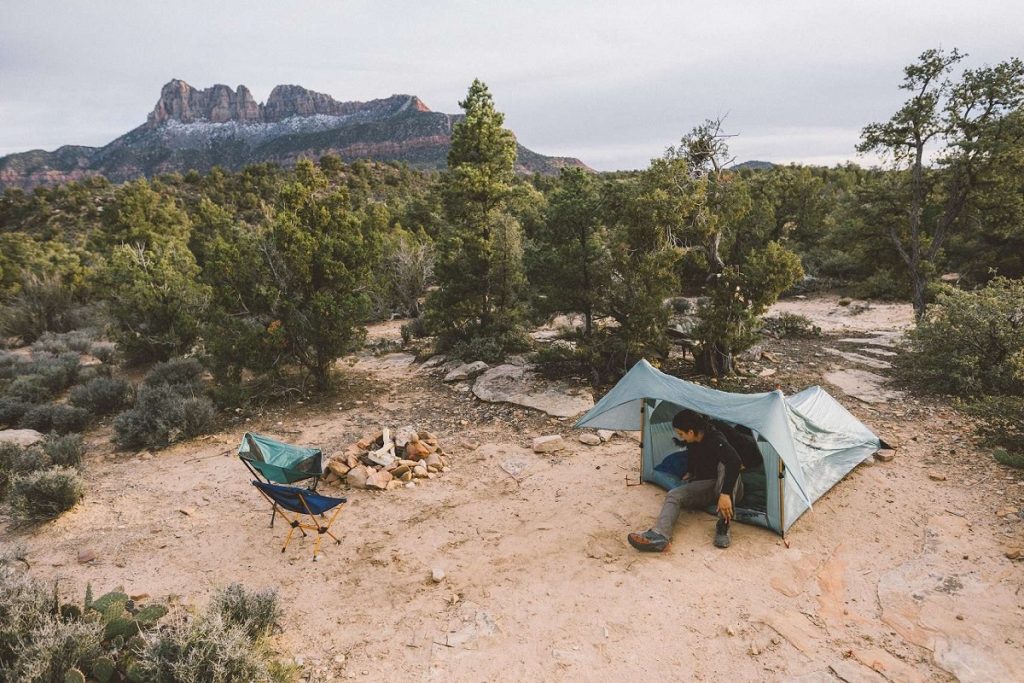
Dispersed Camping - What Is It?
Dispersed camping offers a more challenging wilderness experience to self-sufficient outdoor enthusiasts. By definition, dispersed camping is camping somewhere outside of a designated campground area: in the vast area of a National Park or in one of our great national forests.
As there is no access to campsite amenities like bathrooms, toilets, water pumps, trash cans, and picnic tables, campers rely completely on their own survival skills and preparation. One can come up with a bright idea just to disperse camp near campgrounds, picnic areas, or trailheads - which is a sound idea - but it is NOT allowed.
What else is not allowed? Dispersed camping sounds great and all, but is it legal to just pitch a tent or park an RV wherever you like in the public lands?
Is Dispersed Camping Legal and How to do it?
Since rules and guidelines related to dispersed camping are area-specific, it’s important to contact the local ranger station before heading off. If you’re more of an introvert and prefer to avoid calling altogether, you can also look up the guidelines on the official USDA website pages like Deschutes National Forest.
For example, here are three general rules of dispersed camping:
- Don’t camp in the same location longer than 14 days in a 30-day period. If you wish to say longer than that, move to another dispersed camping area.
- Camp at least 100 feet from any stream or water source.
- Don’t litter and follow the Leave No Trace guidelines: pack-in and pack-out.
And here are two examples of location-specific rules:
- In Kentucky, the law prohibits the consumption and open containers of alcohol in public places, including national forest land and Kentucky lakes and waterways.
- There’s a fee for backcountry camping between 10 pm and 6 am at Red River Gorge.
The rule of thumb is - unless it's stated otherwise, you can spend a night in the public lands, in a tent, or in a vehicle. With great power to camp wherever you want comes great responsibility to preserve the wilderness around you.
Where Can I Disperse Camp?
Unless stated otherwise, dispersed camping is allowed on public lands, such as national forests, Bureau of Land Management areas, and some state parks. Some of these areas have designated dispersed camping zones, and some have restrictions or permit requirements.
It’s considered a good practice to call a local ranger station; the rangers there will help you out and even give you recommendations and suggestions on the best places to camp.
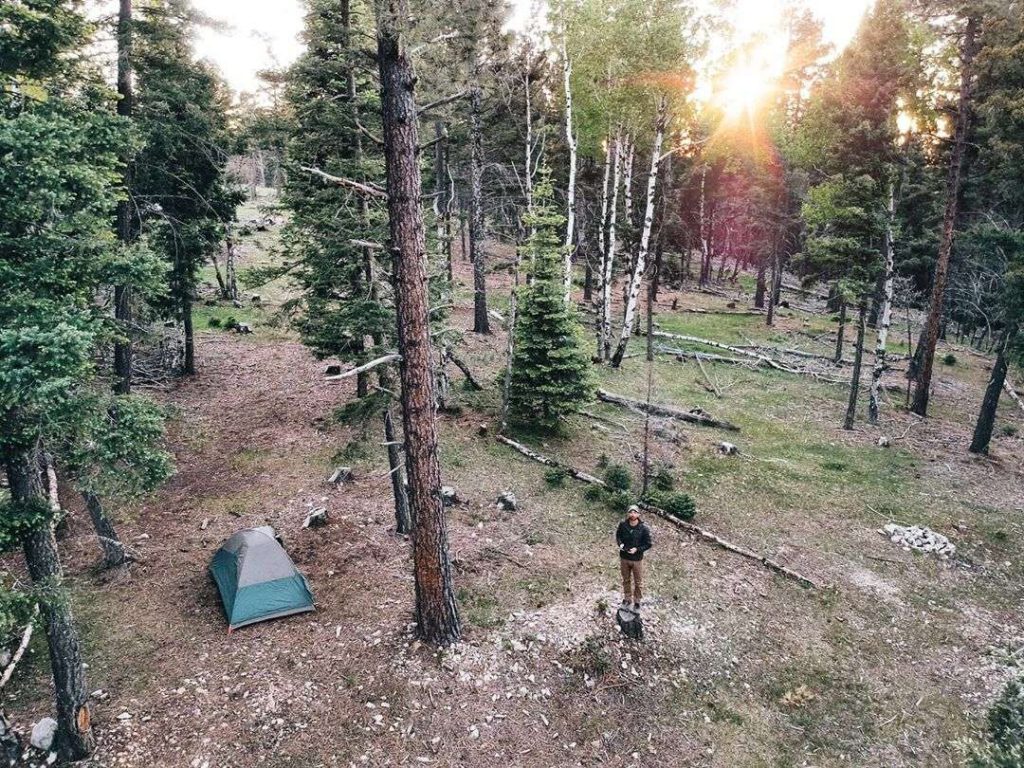
Pros And Cons of Dispersed Camping
Dispersed camping isn’t just a walk in a park (pardon the pun). Like anything worthwhile in life, camping for free on public lands comes with benefits and downsides.
Pros
- Privacy and Solitude: No crowds, no loud neighbors, just birds chirping and creeks splashing.
- Cost Savings: Unless you’re camping in a National or State Park, dispersed camping comes with no fees.
- Natural Surroundings: Camping far from developed land allows you to truly experience the untouched wilderness and increases the chances of spotting wildlife.
- Flexibility and Freedom: You are in full control of organizing your dispersed camping trip and where you want to pitch your tent. No campsite reservations - first-come, first-served.
- Improves Confidence: There is a sense of satisfaction that comes with being truly self-sufficient in the great outdoors.
- Adventure and Exploration: While looking where to make camp, you can discover places with breathtaking views that are just impossible to find near designated campgrounds.
Cons
- Limited Accessibility: Remote locations require more effort to get to and may be inaccessible for certain vehicles and camping rigs.
- Lack of Amenities: There are no amenities like restrooms, running water, RV hookups, or even trash cans. Dispersed camping requires more preparation, as you'll need to bring your own water, food, and other essentials.
- Environmental Impact: Without established facilities, proper waste disposal and adherence to Leave No Trace principles are crucial to minimizing environmental impact.
- Safety Concerns: Remote areas may have limited cell phone reception, emergency services, or assistance in case of emergencies.
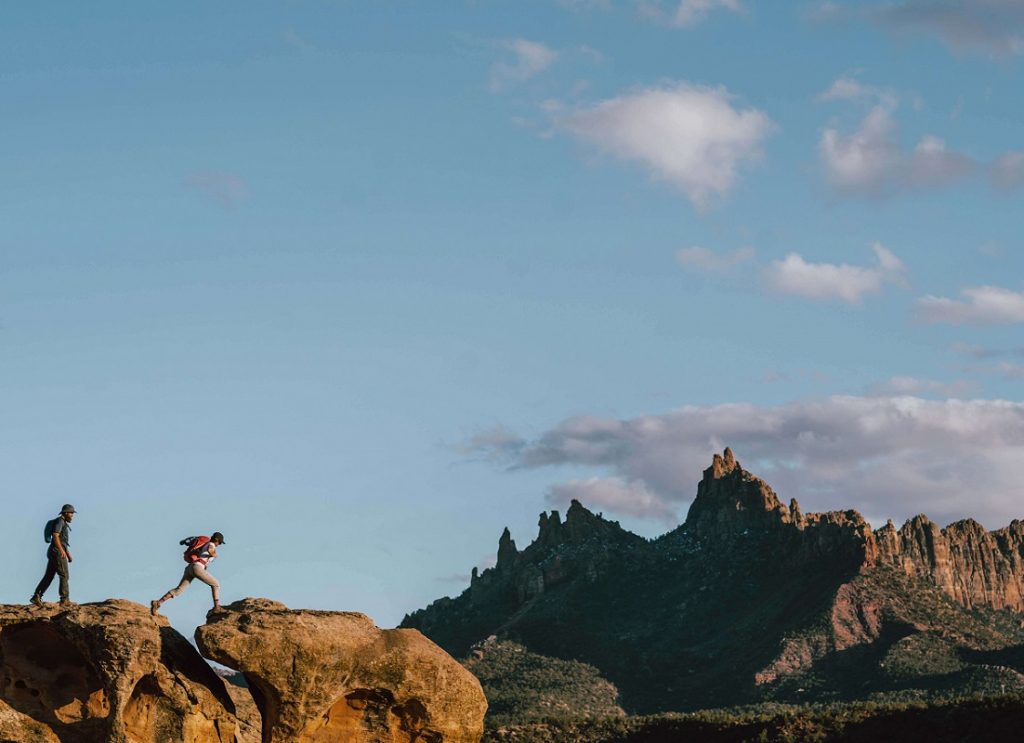
Finding the Perfect Dispersed Camping Spot
Since most dispersed campsites are in discrete locations, it may be difficult to find the spot, even after marking it on the map. However, another challenge adds even more excitement to the overall experience. Just make sure you leave yourself enough daylight before you try to find the marked location.
The vastness of dispersed camping spots in the great outdoors can sometimes feel overwhelming. To avoid unnecessary overthinking, we’ve compiled a few common ways to help you find a perfect location for your trip.
Research Public Lands
First things first, you have to decide on the general area or region where you want to go dispersed camping. Then you’ll need to research and look for national forests, Bureau of Land Management (BLM) areas, or state parks that permit dispersed camping. They often have dispersed camping zones and allow camping outside of established campgrounds.
Look for camping spots near desirable natural features like scenic viewpoints, lakes, and waterfalls. These areas that offer beautiful surroundings and recreational opportunities have a higher chance of already being occupied, so you may end up searching for the camping spot for a lot longer than initially planned.
Utilize Technology
Use the Google Maps satellite view to follow old trails and look at the surrounding areas. Look for light green shaded areas within the public lands.
Consider the accessibility of the camping spots. Look for nearby roads, trails, or designated access points that allow you to reach the desired area with your vehicle or by hiking. Assess the condition of roads and any restrictions on vehicle size or clearance.
Once you find your perfect spot, mark it on the map. Since most dispersed campsites are in remote locations, it may be difficult to find the location while on the ground, even after marking it on the map. Stay on track and make sure you leave yourself enough daylight for the exploration.
Hint: Browse online forums to gather information from people familiar with the camping area.
Ask The Experts
Contact the local ranger station or visitor center in the area you wish to camp. They may provide recommendations, updates on road conditions, or specific regulations such as a fire ban if the woods are particularly dry at that time of the year. Ask about safety considerations such as proximity to wildlife habitats, potential hazards like steep cliffs or unstable terrain, and weather conditions, then choose camping spots that offer a reasonable level of safety and align with your comfort level.
Scout the Area
Once you've identified potential camping spots, if you have the time, consider doing a scouting trip before your actual camping adventure. This allows you to assess the location, terrain, and suitability for your needs firsthand.
How to Find a Dispersed Camping Site on a Map
Here's a step-by-step guide to help you find dispersed camping sites whether you are using a physical or a digital map, or specialized camping apps:
- Locate Dispersed Camping Zones: Open the map and look for green areas within public lands. They are typically marked with symbols or specific names. Pin any interesting spots you see.
- Analyze Topography and Land Features: Apply topography filters and look for features that align with your camping preferences: areas with forests, open meadows, or mountainous regions. Do not camp in the middle of a clearing - it’s frowned upon, okay?
- Evaluate Accessibility: Dispersed camping locations can be found along forest service roads that are often marked and labeled with numbers or letters. Also, look for nearby roads or trails that lead to the camping areas. Consider factors such as distance from main roads, terrain difficulty, and vehicle suitability.
- Assess Proximity to Water: Look for camping sites near bodies of water such as rivers, lakes, or streams. They tend to offer scenic views and potential fishing opportunities. Keep in mind to camp at least 100 feet away from any water source.
- Look Up Local Regulations: Before you head to the chosen camping site, make sure you understand the specific regulations and guidelines for dispersed camping in the area. Note any restrictions, permits, or time limits that may apply.
Then pack and go! Ask Google Maps for directions from your current location to the selected pin or pins. If you’re using a camping app, the pins also come with the coordinates which you can use. Always have a nearby alternative spot just in case your first location is occupied.
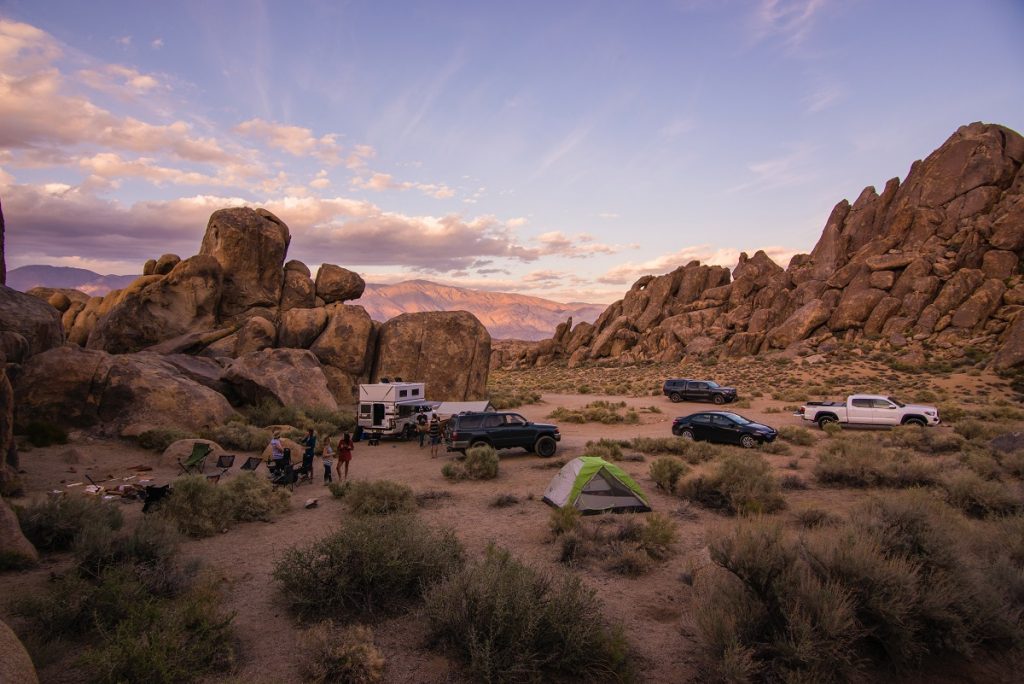
Dispersed Camping With a Vehicle
Looking for car camping spots doesn’t differ that much from the above-mentioned method. There are a few more steps to it, though:
- Identify areas where dispersed camping is allowed and accessible by vehicles. Most of these locations offer free RV camping.
- Check local regulations if there are any specific rules regarding off-road driving, vehicle access, and any restrictions on vehicle size or weight.
- Ensure your rig is equipped for off-road or rough terrain. Check the tires, brakes, fluid levels, and lights. Carry a spare tire, tools, and a tire repair kit in case of an emergency. Make sure you bring the necessary boondocking gear with you.
- Plan your route while taking into account road conditions and fuel availability.
- Check the weather forecast of the area you plan to visit. Expect the unexpected and pack gear and clothing accordingly.
Be mindful of the environment when exploring the wilderness with your vehicle. Respect local regulations and enjoy your trip!
Dispersed Camping Dos and Don’ts
The overarching principle of dispersed camping is to minimize your impact on the natural environment and leave the area as you found it, or even better than you found it. Here’s how you do it:
Dos:
- Do Your Research: Before you set off, get familiar with the rules and regulations specific to the location where you plan to camp. Make sure you know the potential hazards and weather conditions, and follow any fire restrictions or bans in the area.
- Use Existing Roads: Plan a way to get to your dispersed camping site by using existing paths or roads to prevent resource damage.
- Be Self-Sufficient: Pack all the necessary gear such as a map, compass, tent, sleeping bag, first aid kit, water, and food.
- Minimize the Impact on the Environment: Set up camp on a place that has been used before and make sure it’s at least 200 feet away from any water source to protect it from contamination.
- Abide by the Leave No Trace principles: Lead by an example. Pack and take out all trash, minimize campfire impact, respect wildlife, and not disturb the natural environment.
- Sanitation Plan: Have a plan to manage human waste.You may need to pack a portable camping toilet or dig a cathole at least 6-8 inches deep for human waste disposal, and bury it once used.
Don’ts:
- Don't Set Up Camp on Vegetation: Aim to camp on durable surfaces such as established campsites, rock, gravel, dry grasses, or snow.
- Don't Leave a Trace: Do not carve your name into trees, move rocks, or otherwise leave your mark on the environment.
- Don't Light a Fire Unless Permitted: Some areas have strict rules regarding campfires due to the risk of wildfires. If campfires are allowed, use established fire rings, keep fires small, and completely extinguish them when you're done.
- Don't Disregard Local Rules and Regulations: Each area can have different rules about where camping is allowed, when it's allowed, and what activities are permitted. It's essential to respect these rules to preserve the area for future generations. Don’t camp in closed-off or restricted areas. Respect private property boundaries.
- Don't Ignore the Weather Forecast: Weather can change quickly when you're in the wilderness, and being unprepared for a sudden storm or drop in temperature can be dangerous. Always check the weather forecast before you leave, and prepare for the worst-case scenario.
By following these do’s and don’ts, the wilderness can continue to be a source of inspiration and joy for numerous outdoor enthusiasts just like you.
Dispersed Camping Safety Tips
Dispersed camping involves a level of self-sufficiency and risk that can be significantly higher than camping in a designated campground. Here are several safety precautions to consider:
- Weather Forecast: Just like before any outdoor endeavor, check the weather forecast for the entire duration of your trip. As we mentioned above, weather can change quickly, especially in mountainous areas, and can become hazardous without proper preparation.
- Navigation Skills: Make sure you are proficient with a map and compass and always bring these along with you. Do not rely solely on the devices.
- Wildlife Awareness: Be bear aware, but not bearanoid. Learn about local wildlife and how to coexist with them safely. This includes knowing how to store food properly to prevent attracting animals to your site. Use bear-resistant camping food storage containers if camping in bear country.
- Water Purification: Have a reliable method for purifying water. Don’t assume you’ll find potable water.
- Emergency Contacts: Always let someone know where you are going and when you are expected to return. If possible, provide them with a map of your planned route. Also, avoid camping alone, especially in remote areas. There is safety in numbers, especially in case of an emergency.
- First-Aid Kit: Make sure you tick all the boxes on our first-aid checklist and familiarize yourself with how to use each item. We recommend taking a first-aid and CPR course. Extremes of cold or heat can be life-threatening. Recognize the symptoms of both and know how to react accordingly.
- Adequate Gear: Pack weather-appropriate clothing, necessary camping gear, and a backcountry repair kit. This could include extra layers for cold weather, a rainproof tent, and a warm sleeping bag.
Safety is the number one priority when dispersed camping. These precautions can help ensure that your dispersed camping trip is a safe and enjoyable experience. However, remember that every situation is different, and you should use your judgment to evaluate the specific risks associated with your trip.
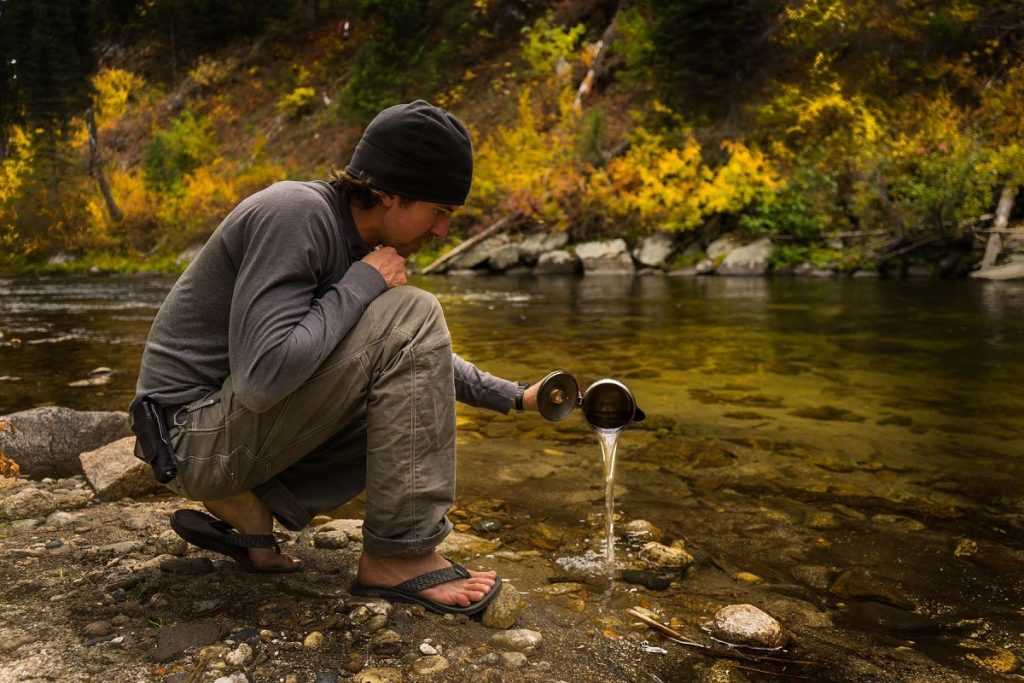
What Should I Bring?
Dispersed camping challenges your preparation and camping skills. Before you head out to the great unknown, you should tick boxes off our camping checklist to prevent any trouble. Remember, since there are no provided amenities on dispersed campsites, you must be self-contained with your supplies.
Shelter and Bedding
- Tent: A 3-season tent is suitable for most camping conditions. Ensure it has a rainfly and groundsheet to protect against wet weather.
- Sleeping Bag: Choose one that is suitable for the lowest temperature you expect. Consider a sleeping pad, air mattress, and pillows for additional comfort and insulation.
- Tarp: Useful for additional ground cover or creating a makeshift shelter.
- Optional: Hammock or bivy sack.
Kitchen Equipment
- A Portable Stove and Fuel: A lightweight, portable stove is a must for preparing hot meals while camping. There are various types, including canisters, liquid fuel, and wood-burning stoves.
- Cooking Pot: A durable pot is necessary for boiling water and cooking easy camping meals. Some pots come with a non-stick coating for easier cooking and cleaning.
- Pan: A frying pan can be useful for cooking more varied meals, especially if you plan on catching fish or foraging. And just like pots, these can also come with a non-stick coating.
- Kitchen Utensils: Pack a foldable set of utensils, specifically designed for camping.
- Mug or Cup: A durable mug or cup is useful for drinking both hot and cold beverages. Look for collapsible cups for easy packing.
- Fire Starter: Waterproof matches or a lighter can help you start a fire for warmth or cooking.
Food & Water
- Non-Perishable Foods: Pack canned or packaged foods, dehydrated or freeze-dried meals, and ready-to-eat foods like pre-cooked rice or pasta. Don’t forget condiments and seasonings!
- Durable Fresh Produce: Bring some apples, oranges, potatoes, garlic, zucchini, carrots, and bell peppers with you.
- Water: Staying hydrated is crucial during all outdoor activities. As there are no water pumps, you need to bring approximately a gallon per person (2-3 liters) per day you plan to spend in the wilderness. If you are winter camping, make sure the water does not freeze!
- Water Filter/Purifier: Since you won't have access to treated water during a dispersed camping trip, bring a way to treat it, like a water filter or purifying tablets.
Camping Gear and Repair Items
- Safety Gear: First-aid kit, emergency blanket, whistle, a flare, EDC light, and a fully charged mobile phone or other communication devices.
- Repair Items: Multi-tool, a knife, a foldable saw, duct tape, rope or cordage, a small sewing kit, and spare equipment.
- Lighting: Headlamp or flashlight with extra batteries.
- Navigation: Map, compass, GPS device, or smartphone with offline maps and a backup power source. However, don't solely rely on electronics for navigation as batteries can die or signal can be lost.
Toiletries
- Personal Hygiene: Biodegradable soap, toothbrush, toothpaste, toilet paper, hand sanitizer, sanitary napkins, and any necessary medications.
- Campsite Hygiene: Bring enough bags to pack out any trash or waste, leaving the camping area clean.
Clothing
If you check the weather forecast and do the research, there is no need to overpack with different kinds of clothing. You know which activities interest you and what are the terrain and weather conditions, so pack accordingly.
Opt for lightweight materials like merino wool or synthetic fabrics that wick moisture away from your skin, helping to keep you dry. Cotton retains moisture, and it can leave you feeling cold when the temperature drops.
Hiking outfits for summer are different from winter ones. In colder areas, consider an insulating layer like a fleece or down jacket, or merino wool sweater: they all keep your body warm. If there’s a chance of rain, pack a rain jacket as well as weather-resistant hiking boots. If you'll be in an area with lots of sun exposure, consider a wide-brimmed hat and a breathable long-sleeve shirt for protection.
Other
- Camping Furniture: Camp chairs, a folding table, or a ground cloth for sitting or organizing gear.
- Entertainment: Books, playing cards, or other forms of entertainment during downtime.
- Protection: Sunscreen, hat, sunglasses, insect repellent, and a whistle for emergencies.
- Personal Items: Identification, cash, phone, camera, and camping permits or relevant documents.
- Bear Canister: If you're in bear country, you'll need to store your food and scented items safely.
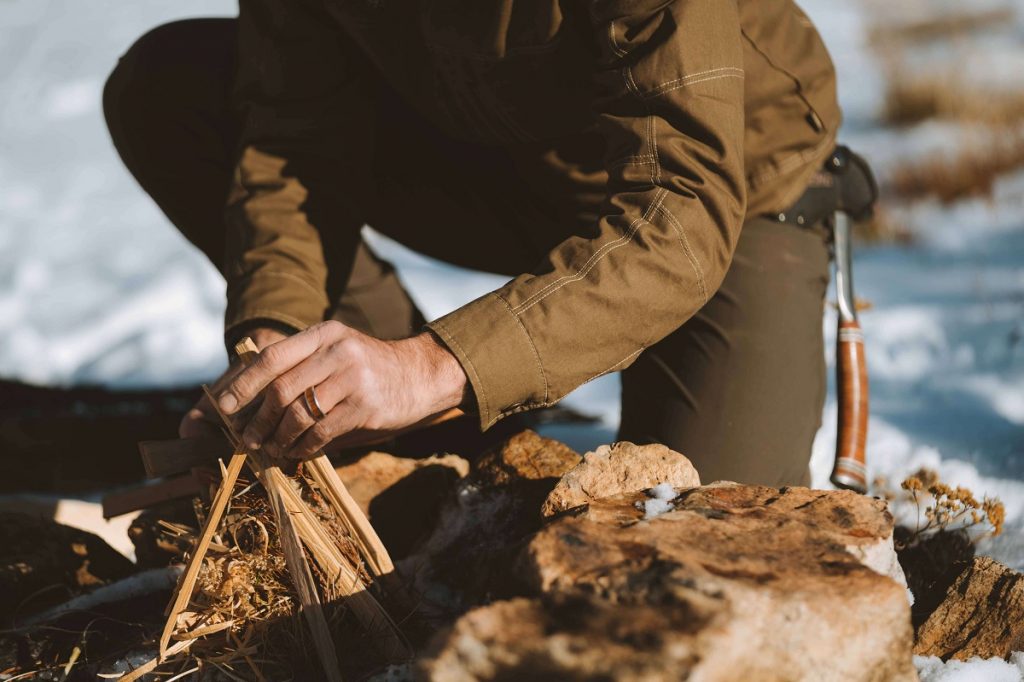
8 Dispersed Camping Tips for Those Who Made it Out Here
- Make sure you find your camping location before it gets dark.
- If campfires are allowed, assess the campsite for fuel sources. Look for dry hardwood with limbs.
- Pack a plastic bottle of water, especially if in a bear area. The crackle will alert the animal to your presence.
- If you're camping without a tent, use pine needles to insulate your sleeping pad from the ground.
- Be on the lookout for opportunities to restock your fire-starting kit with dry leaves, grass, small twigs, pine needles, or tree bark.
- Lightweight and packable powdered food like eggs and beets are a great source of nutrition. However, powdered foods make a bigger mess in your cooking pot.
- When camping in the southeastern states, learn to identify Yaupon trees. They can be an alternative source of caffeine. Use the leaves to make tea.
- Sprinkle water over the campfire to make sure it's extinguished, put some dirt over it, then use your hiking pole to rake leaves and pine needles to make sure you Leave No Trace.
Final Thoughts
Dispersed camping takes the regular camping experience to the next level. As challenging as it may be, it is a unique way to explore and experience the great outdoors - on your own terms. So, lace up your hiking boots, pack your gear, and go find that perfect camping spot. Happy camping!
Featured Image - Squamish Valley on the edge of British Columbia by Scott Goodwill.
FAQs
What is the best website to find dispersed camping?
Campnado is a website that helps you find the best dispersed camping sites everywhere in the United States, it provides useful camping tips and how-tos, and camping gear reviews.
Is it OK to camp without a tent?
In short - yes. Camping without a tent provides an additional level of difficulty to dispersed camping but allows you to truly immerse yourself in the great outdoors. Keep in mind that tentless camping makes you exposed to the elements as well as insects and wildlife.
Where do dogs sleep when tent camping?
Man’s best friend has several accommodation options: they can sleep inside your tent, in a dog-specific tent, or in a dog sleeping bag. If your doggo is comfortable with sleeping outdoors, stake or tether do the trick. Always follow campground regulations regarding dogs!
What is FreeRoam for camping?
FreeRoam is a website and an app that helps you find dispersed campsites on public land. Its layering tool shows precisely where BLM and National Forest boundaries are. There are also fire smoke and fire hazards overlays as well as an elevation overlay. Available in App Store and Google Play.
What is tarp camping?
Tarp camping is a form of tentless camping where you utilize a tarp and various survival techniques to construct a shelter. This way you can protect yourself from the elements while saving on gear weight and have better versatility when setting up your camp.


